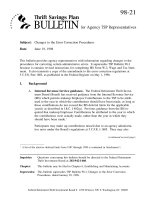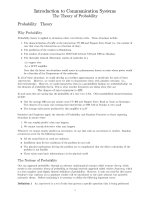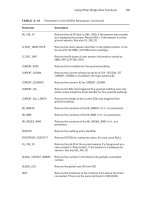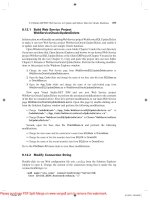Tài liệu ANALOG BEHAVIORAL MODELING WITH THE VERILOG-A LANGUAGE- P5 ppt
Bạn đang xem bản rút gọn của tài liệu. Xem và tải ngay bản đầy đủ của tài liệu tại đây (1.07 MB, 30 trang )
Module Instantiations
ports listed for the module instance must be in the same order as the ports listed in the
module definition. For example, in the a2d module defined previously:
The following instantiates a components
(
msb_a2d
)
of the a2d module defined
above:
The second way to connect module ports consists of explicitly linking the two names
for each side of the connection - the name used in the module definition, followed by
the name used in the instantiating module. This compound name is then placed in the
list of module connections. The name of the port must be the name specified in the
module definition (same as for parameters).
Using connection by name, the previous example can be rewritten:
Declarations and Structural Descriptions
105
Please purchase PDF Split-Merge on www.verypdf.com to remove this watermark.
Declarations and Structural Descriptions
a2d #(.vrange(5.0))
msb_a2d(.d0(bit4), .d1(bit5), .d2(bit6),
.d3(bit7), .in(in), .clk(clock)),
lsb_a2d(.d0(bit0), .d1(bit1), .d2(bit2),
.d3(bit3), .in(gain_out), .clk(clock));
The two types of module port connections can not be mixed; connections to the ports
of a particular module instance must be all by order or all by name. The are rules gov-
erning the way module ports are declared and the way they are interconnected. The
most important of which is that all ports connected to a node must be compatible with
each other as well as to the discipline of the node
1
.
1. The node of any discipline type is compatible in a connection to the ground or ref-
erence node.
106
Verilog-A HDL
Please purchase PDF Split-Merge on www.verypdf.com to remove this watermark.
CHAPTER 5
Applications
5.1 Introduction
The Verilog-A language can be used to describe the analog behaviors of both electri-
cal and non-electrical systems at different levels of abstractions. To illustrate this, a
number of examples are given in this chapter using different modeling objectives and
techniques. The examples illustrated in this chapter include modeling of:
Common emitter amplifier
Voltage regulator
Operational amplifier
QPSK modulator and demodulator
Frequency synthesizer
Position control system
The modeling and characterization of a common emitter amplifier is used to illustrate
three levels of models for the amplifier. The first model is only applicable for mid-
band operation, where gain is constant over a given frequency range. The other two
examples of the common emitter amplifier, show different styles to include gain
behavior outside the midband range. Spice simulation results are provided for refer-
ence.
107
Please purchase PDF Split-Merge on www.verypdf.com to remove this watermark.
An operational amplifier example includes the model of the op amp, including a test
bench model to measure the settling time characteristics of the amplifier. The effects
of poles in the gain/frequency plot is modeled using two techniques. One model uses
a resistor and a capacitor in the transfer function to provide the dominant low fre-
quency pole effect. The other example models a higher frequency second order pole
using a Laplace transform function.
The voltage regulator example includes a bandgap reference circuit which uses a
curve-fitting equation to define the output voltage. The equation includes the effect of
supply voltage and temperature variation. The equation was derived from extrapo-
lated data obtained from transistor-level Spice simulations, traceable to actual silicon.
Three system level examples are also given. The QPSK modulator and demodulator
show high-level modeling of analog behaviors in which nonlinearities are present. A
fractional N-loop frequency synthesizer illustrates analog and digital modeling in a
mixed-signal system. An antenna position-control system is used to illustrate the use
of the Verilog-A language in modeling and optimization of electro-mechanical sys-
tems.
5.2
Behavioral Modeling of a Common Emitter
Amplifier
A single transistor common emitter amplifier is used to illustrate the concept of devel-
oping a model. This classic example provides a good review of basic principals of cir-
cuit design and analysis. It includes DC biasing requirements, transistor parameter
considerations, and AC constraints due to the transistor parasitics and discrete capaci-
tors used in the design.
Results from the simulation of the Verilog-A common emitter amplifier model can be
compared to Spice transistor-level simulations and with laboratory measurements, if
desired.
This section explains a bottom-up methodology of step-wise refinement in analog
behavioral model development consisting of the following:
spice transistor model
functional model
structural model for the behavior .
108
Verilog-A HDL
Please purchase PDF Split-Merge on www.verypdf.com to remove this watermark.
Behavioral Modeling of a Common Emitter Amplifier
behavioral model
It is common to define different levels of abstractions in the model of a component for
either top-down or bottom-up design methodologies. Functional models can be used
to verify connectivity of the component within the system of a larger design, while
more detailed behavioral and transistor-level models can be utilized to investigate
higher-order effects on performance.
The common emitter amplifier circuit to be modeled is shown in Figure 5.1. It con-
tains a generic npn transistor, biasing resistors, and coupling capacitors, designed to
provide a small signal gain of around 25 in the midband frequency range between a
low frequency zero less than and high frequency pole greater than
Typically, Spice circuit simulation results are used as a reference for integrated circuit
model development. The Spice transistor model parameters can be characterized to
agree with silicon test structures, and provide a path to link the simulation results to
the manufacturing process.
109
Please purchase PDF Split-Merge on www.verypdf.com to remove this watermark.
For the purpose of the Verilog-A model development, a test structure, as shown in
Figure 5.2, is utilized for encapsulating the different representations of the amplifier.
The gain block is an inverting amplifier, that is, the output is inverted with respect to
the input. To develop an understanding for the design requirements and constraints,
the amplifier circuit is analyzed in detail, within and outside the midband range.
The Spice input file for the common emitter amplifier is shown in Listing 5.1.
1
LISTING 5.1 Spice listing of common emitter amplifier test bench for
representations of all models in this section.
* title: test bench for models
* Verilog-A input files
.verilog
"
ceamp_fm.va"
.verilog
"
ceamp_rc.va"
.verilog "ceamp_lp.va"
* sources
Vcc 1 0
dc 12
1. The Spice test bench file contains references to all the behavioral models being
developed in this section.
110
Verilog-A HDL
Please purchase PDF Split-Merge on www.verypdf.com to remove this watermark.
Behavioral Modeling of a Common Emitter Amplifier
Vin 6 0 dc 0 ac 1 sin(0 10m 10k)
* biasing resistors
Rs 5 6 4k
Rb1 40
4k
Rb2 1 4 8k
Rc
1 2
6k
Re 3 0
3.3k
* load resistors
Rsp out_sp 0 4k
Rfm out_fm 0 4k
Rrc out_rc 0 4k
Rlp out_lp 0 4k
* coupling capacitors
Cin 541uf
Ce
3 0
10uf
Cout 2 out_sp 1uf
* transistors
Q1 2 4 3 Qnpn
.model Qnpn npn (Is=48.718fA BF=200 BR=100.1m Rb=0
+ Re=0 Rc=0 Cjs=
0F Cje=4.5pF Cjc=3.5pF Vje=750mV
+ Vjc=750mV Tf=461.95ps Tr=10ns mje=333.33m
+ mjc=333.33m VA=200V ISE=0A IKF=10mA Ne=1.5)
* Verilog-A behavioral models
xa1 6 out_fm ceamp_fm gain=25
xa2 6 out_rc ceamp_rc gain=25
xa3 6 out_lp ceamp_lp gain=25
.op
.ac dec 1k 10 100Meg
.tran 1n 200u
.end
The common emitter amplifier is first simulated at the transistor level with Spice for
the amplifier biased in the midband frequency range. The results of running a Spice
111
Please purchase PDF Split-Merge on www.verypdf.com to remove this watermark.
small-signal transient analysis on the common emitter amplifier is shown in Figure
5.3. The transient simulation results of Figure 5.3(a) are used to verify the connectiv-
ity and proper operation of the amplifier. In addition, the small-signal AC response of
Figure 5.3(b) of the amplifier offers some insight into the model requirements.
5.2.1 Functional Model
When the amplifier is used within the midband frequency range, a simple gain model
without frequency effects is adequate for system evaluation purposes. Functional
models are useful for top-level system architectural design and analysis. From the
112
Verilog-A HDL
Please purchase PDF Split-Merge on www.verypdf.com to remove this watermark.
Behavioral Modeling of a Common Emitter Amplifier
previous transistor-level Spice analysis, a simple functional model can be valid for
the midband frequency range between 1kHz to 400kHz. With this simplification, we
only need to focus on modeling the gain characteristics.
With reference to the schematic of Figure 5.1, the gain of the amplifier at midband is
determined using the following equation:
The resistance at the base of the npn is related to the following parameters:
where is the internal resistance of the npn between the base and the emitter, and
is resistance from the external base to the internal intrinsic base of the npn. The effec-
tive load resistance is a parallel combination of resistances at the output node.
The output resistance of the npn is a function of a constant called the Early
voltage, and the collector current The transconductance of the npn is
3.85mA/V at T = 300K and In this example the current is 1mA. With
and using the values from the schematic, and a npn
transistor with a gain equal to 200, the amplifier gain is calculated.
The derived value of is used as the gain value in the simple functional model of
Listing 5.2.
LISTING 5.2 Verilog-A module definition for common emitter amp
113
Please purchase PDF Split-Merge on www.verypdf.com to remove this watermark.
module ceamp_fm(in, out);
inout in, out;
electrical in, out;
parameter real gain = 1.0;
analog begin
V(out) < + V(in)*(-gain);
end
`include "std.va"
endmodule
The gain of the amplifier can be selected with parameters passed into the model from
the test bench (Spice circuit file) or from another Verilog-A module. If a parameter is
not specified during instantiation, the default value declared in the behavioral model
file is
used.
In
this example
the
parameter
gain
is
specified
in the
Spice circuit
file
as,
xa1
in out ceamp_fm gain = 25
and the default value declared in the Verilog-A model file,
parameter
real
gain = 1.0;
System performance can be easily studied with various amplifier gain values by
choosing the value in the Spice circuit file, without having to rewrite and test the
model. The final transistor level circuit design can then be completed and character-
ized with a final gain selected for optimum system level performance. In this example
the gain of the behavioral model was selected to be 25 to match results with Spice
simulations. The results from the transistor-level Spice and functional model simula-
tions are shown in Figure 5.4.
5.2.2 Modeling Higher-Order Effects
Modeling higher-order effects in the common emitter amplifier to account for the fre-
quency response, requires developing an intuitive understanding of the circuits gen-
eral behavior. For example, in the amplifier, the input and output capacitors will
appear as near open circuits at 0 Hz, and as near short circuits at high frequencies
114
Verilog-A HDL
Please purchase PDF Split-Merge on www.verypdf.com to remove this watermark.
Behavioral Modeling of a Common Emitter Amplifier
(although the capacitors do have leakage and resistive components which is not fac-
tored in). The first order basic equation for the gain of the common emitter amplifier,
as a function of frequency is:
Fortunately, there is a dominant low frequency zero which allows the equation to be
simplified, yielding one easier to use while adequately representing the behavior:
The effective emitter resistance, as a function of circuit and npn transistor parameters,
is required in the low frequency zero calculation. It is dependent upon the following
relationship:
115
Please purchase PDF Split-Merge on www.verypdf.com to remove this watermark.
The dominant low frequency zero, as a result of the effective resistance between the
emitter and ground, is given by the following equation:
In a similar fashion, the dominant high frequency pole is approximated by the follow-
ing relationship:
And, as discussed during midband model development, the term is the transistor
transconductance, the parameters and are the dominant intrinsic npn resis-
tances, and the values and are the dominant npn capacitance for the design.
Discrete values from the schematic and parameters from the midband gain analysis
are used in the calculation of and with the following results:
These approximations were verified using the transistor-level Spice small-signal AC
analysis as shown previously in Figure 5.3 (b).
5.2.3 Structural Model of Behavior
As previously discussed, the gain of the amplifier is not constant with respect to fre-
quency because of parasitic capacitances of the transistor, AC coupling capacitors,
and the bypass capacitors. A structural/behavioral model, based upon a classical RC
network using the Verilog-A language, can be used to model the amplifier as a func-
tion of frequency. The simple RC network, followed by the gain stage, is used to
model gain and frequency response characteristics of common emitter amplifier (Fig-
ure 5.5). The gain of the amplifier has been modified to 25 to match the characteristics
116
Verilog-A HDL
Please purchase PDF Split-Merge on www.verypdf.com to remove this watermark.
Behavioral Modeling of a Common Emitter Amplifier
of the Spice model. The other values for the structural RC network were selected by
first setting resistor R1 to 4000 ohms, calculating the capacitance C1 at and then
adjusting the value until the simulation results of the structural model matched the
transistor-level Spice simulation. The calculated value of the capacitance C1 is 68nF.
The value of Cl was tuned to l00nF for use in the simplified behavioral model. The
same procedure is use to determine R2 and C2. Resistor R2 is selected to be 100k,
capacitor C2 was calculated at and tuned to match Spice results. The final value
for C2 is 2.8pF.
The resulting Verilog-A model file is shown in Listing 5.3. Internal nodes are declared
within the module for the RC network. The analog block is used to implement the
behavior.
LISTING
5.3
Verilog-A module of ce-amp w/RC bandpass filter.
`include "std.va"
module mbce_amp_rcn(in, out, gnd);
inout in, out, gnd;
electrical in, out, gnd;
parameter real gain = 1.0;
parameter real r1 = 4k
;
parameter real c1 = 100n;
117
Please purchase PDF Split-Merge on www.verypdf.com to remove this watermark.
parameter real r2 = 100k;
parameter real c2 = 2.8p;
electrical n1;
electrical n2;
analog begin
I(in, n1) < + c1*ddt (V(in, n1));
V(n1, gnd) <+ r1*I(in, n1);
I(n1, n2) <+ V(n1, n2)/r2;
I(n2, gnd) < + c2*ddt(V(n2, gnd));
V(out, gnd) <+ V(n2, gnd)*(-gain);
end
endmodule
Transient analysis of the common emitter amplifier based on the RC bandpass net-
work for a sinusoidal input is shown in Figure 5.6 (a). Figure 5.6 (b) shows the mag-
nitude of the frequency response. Both are compared to the transistor-level
simulations and exhibiting the expected behavior.
5.2.4 Behavioral Model
The Verilog-A language includes built-in Laplace transform functions that implement
lumped linear continuous-time filters. This transform is used to model the frequency
effects of the amplifier by treating the behavior as a simple bandpass filter,
The laplace_nd analog operator is used in this behavioral model to provide the
behavior of the gain with respect to frequency. The simplified form of the frequency
response equation for the amplifier is expanded and coefficients are calculated for use
in the laplace_nd analog operator.
118
Verilog-A HDL
Please purchase PDF Split-Merge on www.verypdf.com to remove this watermark.
Behavioral Modeling of a Common Emitter Amplifier
where,
119
Please purchase PDF Split-Merge on www.verypdf.com to remove this watermark.
are used as the starting point values for the coefficients in the denominator expres-
sion. The coefficients were then tuned to match Spice transistor-level simulations.
LISTING 5.4 Verilog-A model of ce-amp using laplace analog operators
`include
"std.va"
module com_emtr_amp_lp(in, out, gnd);
inout in, out;
electrical in, out;
parameter real gain = 1.0;
analog begin
V(out, gnd) <+ -gain*laplace_nd( V(in),
{ 0.0, 1.0 }, // numerator zeros
{ 3.6k, 1.001, 3.7e-7 } ) ; //
denomenator poles
end
endmodule
After curve-fitting to the transistor-level Spice reference simulation results, the coeffi-
cients for the denominator of the laplace_nd analog operator of the model in List-
ing 5.4 become 2K, 1.001, and 2.7e-7 respectively. The transient and small-signal AC
120
Verilog-A HDL
Please purchase PDF Split-Merge on www.verypdf.com to remove this watermark.
Behavioral Modeling of a Common Emitter Amplifier
analysis for the resulting behavioral model is shown in Figures 5.8 (a) and (b) respec-
tively.
121
Please purchase PDF Split-Merge on www.verypdf.com to remove this watermark.
5.3 A Basic Operational Amplifier
Operational amplifiers are key building blocks for the analog functions used within
signal processing systems. The basic configuration of this op amp as shown in Figure
5.8, is a voltage-to-current converter followed by an inverting voltage amplifier which
drives a current output buffer. The amplifier gain is provide by the first and second
stages. The first stage converts a differential input voltage to a single ended output
current which drives the second gain stage. The bypass capacitor around the sec-
ond stage, ensures stable operation within the intended frequency range of operation
by bypassing higher frequencies around the gain stage, reducing the gain to zero at
some high frequency value. The bypass capacitor will also set the slew rate, or the
maximum rate of change reflected in the output for any given step at the input of the
amplifier, since it must be charged and discharged with current from the input ampli-
fier stage.
Verilog-A HDL
122
5.3.1 Model Development
A variety of modeling levels can be used to describe the operational amplifier. These
range from a simple functional model with a gain equation to sophisticated models
with pole and zero effects, as well as noise behavior, offset and drift effects.
The first example uses a simple model useful for top-level architectural studies. The
symbols to represent the behavior of the basic stages of the op amp are shown in Fig-
ure
5.9.
Please purchase PDF Split-Merge on www.verypdf.com to remove this watermark.
A Basic Operational Amplifier
The input impedance for the op amp is modeled with a simple resistor across the dif-
ferential input. The frequency behavior of the first gain stage is represented by pass-
ing the signal through a laplace transform function filter. The dominant pole
introduced in the second gain stage is modeled using the analog operator in conjunc-
tion with a resistor and a capacitor Note the slew rate of the model is the rate
at which the capacitor can be charged and discharged in this RC low pass filter. The
voltage-controlled voltage source is used to create a zero-impedance output stage
with infinite sourcing capability. In higher-level models the output stage usually con-
tains output impedance and output voltage swing limitation characteristics. These
effects are not included in this model.
The Verilog-A module definition of the op amp using the conceptual model is shown
in Listing 5.5.
LISTING 5.5 Verilog-A model of the operational amplifier
`include “std.va”
`
include "const.va"
module opamp(inm, inp, out);
inout inm, inp, out;
electrical
inm, inp, out;
parameter
rea
l
gain = 250k;
parameter real rgm = 2.3k;
parameter real cc = 30p;
parameter real rin = 2Meg;
123
Please purchase PDF Split-Merge on www.verypdf.com to remove this watermark.
electrical
vin, vo;
analog begin
I(inp, inm) <+ V(inp, inm)/rgm;
V(vin) < + laplace_nd(gain*V(inp, inm),
{ 1.0 },{ 1.0, 5.0e-7 });
I(vin, vo) <+ V(vin, vo)/rgm;
I(vo) < + ddt(cc*V(vo));
V(out) <+ V(vo);
end
endmodule
For the purpose of the Verilog-A model development, a test structure symbol, as
shown in Figure 5.10, is utilized to encapsulate the amplifier. In addition to develop-
124
Verilog-A HDL
ing the behavioral model, the Verilog-A language is used in the characterization of the
Please purchase PDF Split-Merge on www.verypdf.com to remove this watermark.
A Basic Operational Amplifier
operational amplifier. Here, we will develop a module that sets up the step input and
measures the settling time at the output of the op amp.
Listing 5.6 shows the circuit file for the operational amplifier circuit used to test the
model:
LISTING 5.6 Spice netlist of the operational amplifier test bench
* basic operational amplifier
.verilog "op_amp.va"
Vb inp 0 dc 0
Vin 1 0 dc 0 ac 1 sin(0 10m 1k 0 0)
xamp1 inm inp out 0 opamp
Rin 1 inm 10k
Rf inm out
100k
Rload out 0 100k
Cload out 0 20p
.op
.ac dec 100 0.1 10Meg
.tran 10u 3m
.end
The magnitude response of the op amp for AC small-signal simulation results of the
operational amplifier are shown in Figure 5.11. The bode plot shows both the low and
high-frequency poles of the op amp.
125
Please purchase PDF Split-Merge on www.verypdf.com to remove this watermark.
The op amp transient response to a sinusoidal input verifying the functionality of the
model is shown in Figure 5.12.
126
Verilog-A HDL
Please purchase PDF Split-Merge on www.verypdf.com to remove this watermark.
A Basic Operational Amplifier
Measuring the settling time of an operational amplifier can be automated by develop-
ment of a Verilog-A module that acts as a test bench for the device under test. The
conceptual approach is illustrated in Figure 5.13. A measurement module sets up a
stimulus to the Device Under Test (or DUT) under known conditions and records the
results. At the end of the simulation, the measure results are summarized.
127
5.3.2 Settling Time Measurement
The module (Listing 5.7) performs the measurement using a timer analog operator
to initialize a step on the stimulus signal that provides the input to the operational
amplifier. The measurement module then senses the crossings of the output of the
module when they are within +/- 5% of the final state value. The times of the cross-
ings are recorded, the settling time being the difference between the latest crossing
time and the start of the stimulus step input.
LISTING 5.7 Verilog-A model of settling-time test bench measurement
module settling_test(stim, meas);
inout stim, meas;
electrical stim, meas;
parameter real vstep = 5.0;
parameter real tstart = 1.0u;
parameter real interval = 10.0u;
real vstim;
real
last;
analog begin
// generate stimulus
Please purchase PDF Split-Merge on www.verypdf.com to remove this watermark.
vstim = vstep;
last = tstart;
end
V(stim) <+ transition(vstim, 0.0, 1.0n, 1.0n);
// measure results - op amp is in inverting
@(cross(V(meas) - 1.05*vstep, -1.0)) begin
last = $realtime();
end
@(cross(V(meas) - 0.95*vstep, +1.0)) begin
last = $realtime();
end
// report at end of measurement interval.
@
(
timer(interval)) begin
$strobe(“settling time = %g s.”,
last - tstart);
@(timer(tstart)) begin
endmodule
end
end
128
Verilog-A HDL
Please purchase PDF Split-Merge on www.verypdf.com to remove this watermark.
Voltage Regulator
The result of the measurement is printed to the standard output using the $strobe
system task. The results of the measurement simulation are shown in Figure 5.14. The
results for the simulation are recorded to the standard output as:
settling time = 2.84e-06 s.
5.4 Voltage Regulator
The architecture of the voltage regulator (Figure 5.15), is composed of a bandgap ref-
erence model, the operational amplifier model from Section 5.3, a module to repre-
sent the current of the op amp, and a switch model. The bandgap reference circuit
which a curve-fitting equation to define the output voltage. The equation includes the
effect of supply voltage and temperature variation. The equation was derived from
extrapolated data obtained from transistor-level Spice simulations, traceable to actual
129
Please purchase PDF Split-Merge on www.verypdf.com to remove this watermark.









